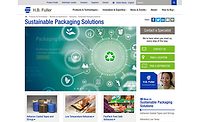Developing Sustainable Packaging Solutions
Recycling and recyclability are key factors that sustainable packaging producer EcoEnclose considers when developing ecommerce packaging solutions.


EcoEnclose paper mailers are 100% recycled and recyclable.

EcoEnclose’s custom printing capabilities give companies the ability to add branding to their sustainable packages.



Many industries have struggled due to the impact of COVID-19, but ecommerce certainly isn’t one of them. eMarketer reports that retail ecommerce sales alone grew 27.6% globally in 2020, to reach nearly $4.3 trillion. Though ecommerce growth in the retail space is expected to decelerate as pandemic restrictions ease and vaccinations climb, it is still projected to see a healthy increase of 14.3% this year.1
The massive increase in ecommerce shipments has led to a profusion of packaging materials. As Saloni Doshi, CEO of EcoEnclose, asks, “How many of us have a garage or a room full of boxes that we’re trying to figure out how to recycle? As ecommerce grows, people are even more and more cognizant of, ‘OK, there’s so much packaging, what can I do?’”
Doshi actually took this question to heart back in 2015, when she and her husband purchased EcoEnclose from company founder Erin Kimmet. “We were really excited about the work that she had done to build the beginning of this idea—let’s take packaging that’s out there and make it more sustainable,” Doshi says.
What started as a small operation with four or five employees has grown to develop and produce myriad types of sustainable packages, from poly and paper mailers to custom corrugate boxes, the majority of which are 100% recycled and recyclable. I recently spoke with Doshi about the company, its assessment and use of sustainable adhesives, and what she envisions for the future of sustainable packaging.
What products does EcoEnclose offer now?
We have a 100% recycled poly mailer, and 50% of it is post-consumer waste, which is really exciting. We’ve got a line of various paper mailers, all of which are 100% recycled. We make hundreds upon hundreds of custom boxes every day … and those are also 100% recycled, 90%-plus post consumer.
We also have a range of post-production custom printing capabilities. For just 500 mailers or more, a company can get their brand on the package. And we have packaging accessories like shipping labels that are 100% recycled, recyclable tape, packaging paper, and void fill.
What we’re focused on is asking: What does every different type of company need to package? What packaging do they need to ship their goods, and how can we make those things more sustainable?
Firm pressure is all that is required to seal these 100% recycled paper mailers.
You mentioned tapes and labels. Can you go into a little bit more detail about the types of adhesives that you use?
When we think about adhesives, it’s a combination of two things. The first is adhesive strength, and the reason for that is because recycled paper is really hard to adhere to. We’ve got all of these boxes that are 100% recycled that have shorter fibers than a virgin box counterpart, and what we were finding is that traditional labels, like a UPS shipping label, wouldn’t adhere very well. It was probably made with an all-temp, all-purpose acrylic emulsion adhesive. We also have something called a padded mailer, which is really cushioned, and that uneven surface made those traditional labels a little bit harder to adhere.
The second thing we consider is adhesives on our own unique, sustainable labels. We created a product with a manufacturing partner that is a really unique shipping label because the release liner is 100% recycled and curbside recyclable. It’s a patented product and only created with this one manufacturing partner. We call it the zero-waste label, and we were so excited about it. But we found that even in our warehouse, when we were shipping to our customers, the original adhesive we used wasn’t strong enough and was peeling off our 100% recycled boxes.
We realized that we can’t have a sustainable alternative label out there that’s not working because the boxes wouldn’t get to where they’re going. That’s not sustainable at all. We then moved to a higher strength corrugate adhesive, and it’s just been working beautifully.
After experiencing adhesion issues with its new zero-waste shipping label liner, EcoEnclose switched to a stronger corrugate adhesive.
We also found with the padded mailer I was describing, which is a 100% recycled mailer that’s stuffed with shredded newsprint and has this uneven surface, even our corrugate-strength acrylic emulsion adhesive wasn’t working. A lot of our customers actually put clear plastic tape over the shipping label for it to work. But that’s no good, because then you’re just recycling a bunch of plastic tape.
For that line, we’ve introduced hot-melt adhesive shipping labels. They’re pure polymer adhesive, so in some ways it’s not the level of sustainability we would want from the label itself. But, it adheres to that padded mailer and you don’t have to tape it up, making the entire package more effective and sustainable.
For us, especially with adhesives and labels, the first thing we want to make sure is the label is going to stick to the recycled paper package and get delivered safely. The least sustainable thing we can do is not get the package there. Then the second is, as much as possible, designing packaging and labels for recyclability with those recycle-compatible adhesives.
What do you see for sustainable packaging in terms of trends for the future?
When I look at the future of packaging, I have two mindsets. One is increased amount of reusability. Right now, a couple of our mailers are inherently reusable. They’ve got a dual tear strip on them, so somebody can either use the package to ship to somebody else or they can ship their returns back in it. If you can get two or three or four life cycles out of a package, that’s incredible. And then it gets recycled.
Another area that I see a lot of growth in is that we need to drastically improve recycling rates and the recycling infrastructure in our country. I’m thinking about my garage that’s full of boxes right now. I run a business that has a baler and that gets a pickup for corrugate, and I’m still sitting on all of this.
All of us should be able to get our cardboard and our paper and our plastic back to a recycling infrastructure where they can cost effectively and really efficiently turn that back into new product. We need to, as a country, make investments in the recycling infrastructure so that each material can have its life extended, hopefully five, six, seven, eight, nine times before it goes away.
I also think a lot of ecommerce brands that are focused on sustainability are trying to figure out how to make paper products work for them. We offer a 100% recycled poly mailer, but there is no plastic that’s durable enough to make it through a supply chain that is going to then fully biodegrade in the ocean, even if it’s made of bioplastic.
And so I think those companies are being really thoughtful: ‘How can I make sure that it’s going to not rip in transit, and it’s going to hold itself together, not get torn, and still be presentable at the customer’s doorstep?’ Paper solutions are more likely to be recycled, and they’re not going to contribute to ocean plastic pollution, so let’s figure out how to make them work well for ecommerce.
To listen to our full conversation with Saloni Doshi, tune in to the Bonding with ASI podcast. Visit www.ecoenclose.com to learn more.
Note: Images and video content provided by EcoEnclose.
Reference
- Cramer-Flood, E., “Global Ecommerce Update 2021,” January 13, 2021, www.emarketer.com/content/global-ecommerce-update-2021.
Looking for a reprint of this article?
From high-res PDFs to custom plaques, order your copy today!









